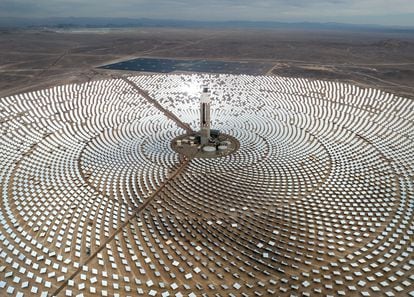Chile, the land of mines, leads the way in solar energy
The Latin American country has far exceeded its goal to reach 20% of energy production from renewable sources by 2025


In the middle of the Atacama Desert, 10,600 mirrors face skyward. Each one measures 140 square meters and weighs about three tons. Their function is to follow the sun’s trajectory, reflecting and directing the radiation towards the receiver and converting it into energy. The Concentrated Solar Power plant occupies 1,000 hectares and is located in northern Chile’s Cerro Dominador. This area has the highest level of solar incidence in the world and is the site of Latin America’s first solar thermal plant. Most of the country’s clean energy is generated there and, because of the plant, Chile achieved one of its most ambitious environmental targets last year, four years ahead of schedule.
The country set itself the goal of producing 20% of its energy from non-conventional renewable energy (NCRE) by 2025. This year, the percentage has already reached 31.1%, according to the Chilean Association of Renewable Energies and Storage (Acera). This comes primarily from photovoltaic energy, which represents 15% of the country’s renewable energy. Cerro Dominador’s proximity to Chile’s large mining areas has also made it easier for that industry to incorporate more solar energy. In 2019, mining’s use of renewable energies did not exceed 3.6%, but it rose to 10.5% in 2020. In 2021, solar energy consumption in the mining sector reached the milestone of 36.2%. That rate is projected to climb to 50% by the end of this fiscal year.
The turning point came in 2013. Over the last decade, clean technology prices have fallen by almost 90%, a trend that is set to continue. Javier Jorquera Copier, an analyst at the International Energy Agency, says that the boom in renewable energy sources is multifactorial and promising: “Government-led auction schemes, competitive bidding in the deregulated electricity market and, more recently, the country’s hydrogen strategy, are driving the solar PV boom in Chile,” he says.
Although Chile hasn’t implemented subsidies for large-scale solar generation, there are some government incentives for people to install solar panels at the residential level, such as the public solar roofs program and net billing, an initiative that allows Chileans to generate their own energy, consume it, and sell their surplus at a set price. Constanza Levicán, an electrical engineer and the founder of Suncast, a Chilean startup that uses artificial intelligence to assess NCRE, is somewhat more critical of the state’s failure to intervene. “If Chile had promoted this industry earlier, it could have positioned itself as an expert in the sector and exported its services to the world,” she says.
Chile has optimal conditions for clean energy production
Nevertheless, Chile has made one of the fastest green transitions in the world, according to Fernando Branger, an energy specialist coordinator at the Inter-American Development Bank. As he explains, the country has opted for a “powerful diversification of energy sources” as a result of greater awareness of global warming and international emission reduction targets. “On top of that, they have the resources. Just as their land is good for [producing] wine, it’s also good for generating solar energy,” he explains via a video call. “The mining industry worked to include it, and there are financial instruments that compensate for the fact that solar energy does not work at night.”
Chile’s conditions are optimal. The Atacama Desert’s average solar irradiation is approximately double the average of Spain’s, for example. Álvaro Lorca, a professor of engineering in the Department of Electrical Engineering at the Catholic University of Chile agrees about the importance of changing the narrative around emissions and climate change. “A real effort goes into making that transition and doing away with coal as well,” he explains. The government’s goal is to eliminate this energy source entirely by 2040 and “everything points to the fact that it could be replaced by solar. It is already competitive in the market today,” Lorca adds.
Switching a third of the country’s energy to clean sources in such a short timeframe makes the commitment to sustainability tangible. In fact, Chile’s new National Energy Policy is even more ambitious; it aims to reach a target of 80% by 2030, which is a “feasible” goal, according to experts. Thus, Chile is paving the way for a region that currently generates 61% of its power capacity is from renewables, according to Energy Global.
However, solar and wind energy pose a significant challenge: transmitting production from sunny and windy areas to the places where energy demand is greastest, something which does not coincide geographically in Chile. “The solar photovoltaic plants in the north have not been able to pump electricity into the system at maximum potential, because of the lack of transmission capacity. The slow expansion of that infrastructure has caused delays in projects in the past and could slow the pace of expansion in the near future,” says Jorquera.
The most viable solution for resolving that shortfall involves investing in batteries that store production at night to avoid spillage and waste. “That is the next step. Chile will require more precise regulations to correct some inefficiencies,” says Branger. Those must be the next steps to be taken if Chile is to continue to lead in the field of renewable energy, he notes.
/cloudfront-eu-central-1.images.arcpublishing.com/prisa/5ZTWQ2CDVEBZZNLJNKC2JHJ2V4.jpg)










































